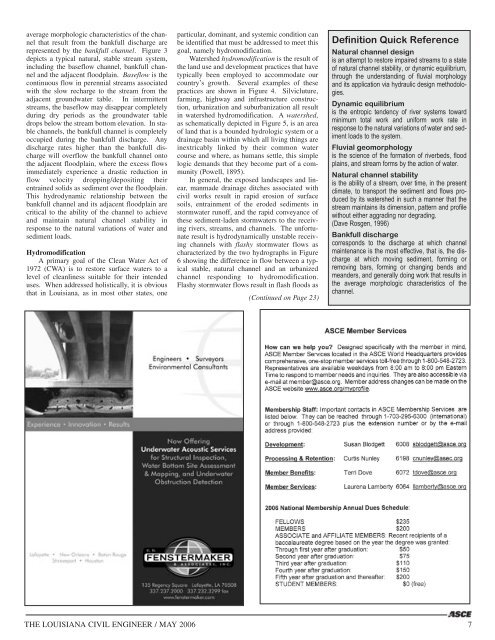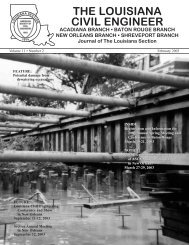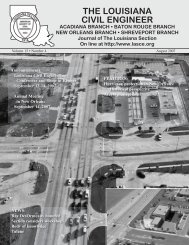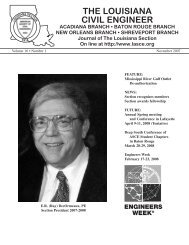THE LOUISIANA CIVIL ENGINEER - lasce
THE LOUISIANA CIVIL ENGINEER - lasce
THE LOUISIANA CIVIL ENGINEER - lasce
Create successful ePaper yourself
Turn your PDF publications into a flip-book with our unique Google optimized e-Paper software.
average morphologic characteristics of the channel<br />
that result from the bankfull discharge are<br />
represented by the bankfull channel. Figure 3<br />
depicts a typical natural, stable stream system,<br />
including the baseflow channel, bankfull channel<br />
and the adjacent floodplain. Baseflow is the<br />
continuous flow in perennial streams associated<br />
with the slow recharge to the stream from the<br />
adjacent groundwater table. In intermittent<br />
streams, the baseflow may disappear completely<br />
during dry periods as the groundwater table<br />
drops below the stream bottom elevation. In stable<br />
channels, the bankfull channel is completely<br />
occupied during the bankfull discharge. Any<br />
discharge rates higher than the bankfull discharge<br />
will overflow the bankfull channel onto<br />
the adjacent floodplain, where the excess flows<br />
immediately experience a drastic reduction in<br />
flow velocity dropping/depositing their<br />
entrained solids as sediment over the floodplain.<br />
This hydrodynamic relationship between the<br />
bankfull channel and its adjacent floodplain are<br />
critical to the ability of the channel to achieve<br />
and maintain natural channel stability in<br />
response to the natural variations of water and<br />
sediment loads.<br />
Hydromodification<br />
A primary goal of the Clean Water Act of<br />
1972 (CWA) is to restore surface waters to a<br />
level of cleanliness suitable for their intended<br />
uses. When addressed holistically, it is obvious<br />
that in Louisiana, as in most other states, one<br />
particular, dominant, and systemic condition can<br />
be identified that must be addressed to meet this<br />
goal, namely hydromodification.<br />
Watershed hydromodification is the result of<br />
the land use and development practices that have<br />
typically been employed to accommodate our<br />
country’s growth. Several examples of these<br />
practices are shown in Figure 4. Silvicluture,<br />
farming, highway and infrastructure construction,<br />
urbanization and suburbanization all result<br />
in watershed hydromodification. A watershed,<br />
as schematically depicted in Figure 5, is an area<br />
of land that is a bounded hydrologic system or a<br />
drainage basin within which all living things are<br />
inextricably linked by their common water<br />
course and where, as humans settle, this simple<br />
logic demands that they become part of a community<br />
(Powell, 1895).<br />
In general, the exposed landscapes and linear,<br />
manmade drainage ditches associated with<br />
civil works result in rapid erosion of surface<br />
soils, entrainment of the eroded sediments in<br />
stormwater runoff, and the rapid conveyance of<br />
these sediment-laden stormwaters to the receiving<br />
rivers, streams, and channels. The unfortunate<br />
result is hydrodynamically unstable receiving<br />
channels with flashy stormwater flows as<br />
characterized by the two hydrographs in Figure<br />
6 showing the difference in flow between a typical<br />
stable, natural channel and an urbanized<br />
channel responding to hydromodification.<br />
Flashy stormwater flows result in flash floods as<br />
(Continued on Page 23)<br />
Definition Quick Reference<br />
Natural channel design<br />
is an attempt to restore impaired streams to a state<br />
of natural channel stability, or dynamic equilibrium,<br />
through the understanding of fluvial morphology<br />
and its application via hydraulic design methodologies.<br />
Dynamic equilibrium<br />
is the entropic tendency of river systems toward<br />
minimum total work and uniform work rate in<br />
response to the natural variations of water and sediment<br />
loads to the system.<br />
Fluvial geomorphology<br />
is the science of the formation of riverbeds, flood<br />
plains, and stream forms by the action of water.<br />
Natural channel stability<br />
is the ability of a stream, over time, in the present<br />
climate, to transport the sediment and flows produced<br />
by its watershed in such a manner that the<br />
stream maintains its dimension, pattern and profile<br />
without either aggrading nor degrading.<br />
(Dave Rosgen, 1996)<br />
Bankfull discharge<br />
corresponds to the discharge at which channel<br />
maintenance is the most effective, that is, the discharge<br />
at which moving sediment, forming or<br />
removing bars, forming or changing bends and<br />
meanders, and generally doing work that results in<br />
the average morphologic characteristics of the<br />
channel.<br />
<strong>THE</strong> <strong>LOUISIANA</strong> <strong>CIVIL</strong> <strong>ENGINEER</strong> / MAY 2006 7






